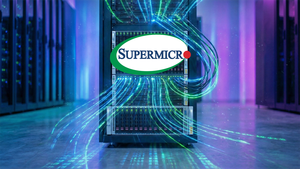
New York, NY – September 29, 2025 – TeraWulf Inc. (NASDAQ: WULF), a prominent digital asset technology company, witnessed a significant uplift in its stock today, closing up by 6.28% amidst a wave of heightened market confidence. The impressive rally pushed the company's shares to a new 52-week high, underscoring strong investor sentiment driven by strategic partnerships, robust financial performance, and an ambitious expansion into high-performance computing (HPC) solutions. This surge highlights a pivotal moment for TeraWulf, positioning it as a key player in the evolving landscape of sustainable digital infrastructure.
The immediate implications of this surge are substantial, signaling a renewed investor appetite for companies at the intersection of sustainable energy and advanced computing. TeraWulf's performance today not only reflects its individual successes but also hints at broader positive trends within the digital asset and AI infrastructure sectors. The market's reaction suggests a strong endorsement of the company's strategic direction, particularly its focus on environmentally conscious operations and its capacity to attract major tech partnerships.
Unpacking the Ascent: A Deep Dive into TeraWulf's Recent Triumphs
TeraWulf Inc.'s remarkable 6.28% gain on September 29, 2025, culminating in a new 52-week high, is the result of a confluence of strategic maneuvers and impressive operational achievements. At its core, TeraWulf is a digital asset technology company specializing in environmentally conscious Bitcoin mining and high-performance computing (HPC) data center solutions across the United States. Its infrastructure is designed to integrate advanced computing with sustainable energy sources, including nuclear, hydro, and solar, setting it apart in an energy-intensive industry.
The timeline of events leading to this moment reveals a carefully orchestrated expansion and strengthening of the company's market position. A significant turning point was the announcement of a planned $3 billion expansion of its data centers, crucially backed by an investment from Google Inc. This strategic partnership saw Google acquiring a 14% stake in TeraWulf, a clear signal of confidence from one of the world's largest technology giants. Further solidifying this alliance, TeraWulf secured a substantial colocation deal with Fluidstack, an AI cloud provider, expanding to over 360 megawatts of compute capacity valued at an astounding $6.7 billion. Google's role as a "backstopper" in this agreement, committing up to $3.2 billion to TeraWulf if Fluidstack defaults, has significantly de-risked the venture and bolstered financial stability.
Beyond partnerships, positive analyst sentiment has played a crucial role. Firms like Roth Capital, Rosenblatt Securities, Cantor Fitzgerald, Northland Securities, JMP Securities, and B. Riley have all issued optimistic forecasts, raising price targets and maintaining "Buy" or "Outperform" ratings. These upgrades frequently cited the company's expanding demand in HPC and AI-driven solutions, along with the Google investment, as primary drivers.
Moreover, TeraWulf's proactive debt financing initiatives have instilled further confidence. The company aims to raise $3 billion through debt financing, coordinated by Morgan Stanley and supported by Google, to fortify its competitive standing in the data center market. It successfully raised $1 billion through convertible notes, demonstrating strong investor interest in its growth trajectory. Financially, TeraWulf reported an impressive 34% year-over-year revenue growth in Q2 2025, reaching $47.6 million, coupled with a robust cash and Bitcoin reserve of $90 million, underscoring its solid financial health and successful diversification into high-efficiency computing services.
Market Ripple Effects: Winners and Losers in a Shifting Landscape
TeraWulf's (NASDAQ: WULF) impressive surge today, largely propelled by its strategic partnership with Google and expansion into high-performance computing, is poised to create significant ripple effects across the digital asset and data center industries, delineating clear winners and potential challenges for others.
The most immediate beneficiary is, of course, TeraWulf itself. The substantial investment and "backstopping" agreement from Google not only injects significant capital but also confers a powerful stamp of legitimacy and long-term stability. This partnership dramatically enhances TeraWulf's capacity for growth, allowing it to accelerate its data center expansion and solidify its position as a leader in sustainable computing infrastructure. The increased market confidence, reflected in today's stock performance, will likely translate into easier access to future capital and improved bargaining power in strategic deals. Furthermore, its focus on environmentally conscious operations aligns with growing ESG (Environmental, Social, and Governance) investment trends, potentially attracting a broader base of institutional investors.
For other large-scale Bitcoin miners and data center operators, TeraWulf's success presents a mixed bag. Companies that have similarly invested in sustainable energy solutions and diversified into HPC services might see a positive halo effect, with investors re-evaluating their potential. However, those heavily reliant solely on Bitcoin mining, particularly with less efficient or less sustainable operations, could face increased competitive pressure. TeraWulf's ability to secure a major tech giant like Google as a partner raises the bar for strategic alliances, potentially leaving smaller or less innovative players struggling to compete for similar high-value contracts and investments. Competitors in the HPC and AI cloud space, such as CoreWeave or Lambda Labs, might also feel the competitive heat, as TeraWulf, backed by Google, aggressively expands its capacity and service offerings.
The traditional energy sector, particularly renewable energy providers, could also indirectly benefit. As companies like TeraWulf prioritize sustainable power sources for their expanding data centers, demand for green energy solutions will likely increase, creating opportunities for utility companies and renewable energy developers. Conversely, energy providers still heavily reliant on fossil fuels might find themselves at a disadvantage if the trend towards sustainable computing continues to accelerate, driven by industry leaders and major tech players.
Broader Implications: Reshaping the Digital Infrastructure Landscape
TeraWulf's (NASDAQ: WULF) ascendancy, underpinned by its strategic alliance with Google and its pivot towards high-performance computing (HPC), signifies more than just a single company's success; it represents a significant shift in broader industry trends within the digital asset and data center sectors. This event underscores a growing convergence between cryptocurrency mining infrastructure and the burgeoning demand for AI and machine learning compute power. Companies that can leverage their existing energy infrastructure for dual purposes – Bitcoin mining and HPC – are poised to capture a larger share of the digital economy.
This development will likely have ripple effects across the entire ecosystem. For competitors, particularly other Bitcoin miners, the pressure to diversify and enhance sustainability will intensify. The traditional model of solely focusing on Bitcoin mining, often with less emphasis on green energy or diversified revenue streams, may become increasingly unsustainable. Companies like Marathon Digital Holdings (NASDAQ: MARA) or Riot Platforms (NASDAQ: RIOT) might need to strategically re-evaluate their long-term growth strategies, potentially exploring similar partnerships or expanding their HPC capabilities to remain competitive. The Google partnership also sets a new precedent for the level of institutional backing and strategic collaboration that is now possible within this industry.
Regulatory and policy implications are also noteworthy. As major tech players like Google invest in digital asset infrastructure, there could be increased scrutiny and a push for clearer regulations around energy consumption, environmental impact, and data center operations. Governments and environmental agencies might view these partnerships as an opportunity to enforce stricter green energy mandates or incentivize sustainable practices across the sector. This could accelerate the transition away from carbon-intensive mining operations, aligning with global climate goals.
Historically, the industry has seen periods of rapid expansion and consolidation, often driven by technological advancements or significant capital injections. TeraWulf's current trajectory can be compared to the early days of cloud computing, where strategic partnerships and massive infrastructure investments laid the groundwork for future dominance. The integration of AI compute with digital asset infrastructure could herald a new era, similar to how the rise of large-scale data centers transformed enterprise IT. This event demonstrates that the capital markets are increasingly valuing companies that can demonstrate innovation, sustainability, and strategic foresight in a rapidly evolving technological landscape.
What Comes Next: Charting TeraWulf's Future and Market Dynamics
The path forward for TeraWulf (NASDAQ: WULF) and the broader digital infrastructure market appears dynamic, marked by both immense opportunities and potential challenges. In the short term, the company is likely to focus intently on executing its $3 billion data center expansion plan, particularly the build-out of the 360-megawatt compute capacity for Fluidstack, backed by Google. Successful and timely completion of these projects will be crucial for maintaining investor confidence and realizing the projected $6.7 billion in revenue. Investors should watch for updates on construction progress, deployment of new computing units, and any further announcements regarding the Google partnership.
Long-term possibilities for TeraWulf are extensive. The strong foundation laid by its sustainable energy focus and the Google alliance positions it to become a dominant force not just in Bitcoin mining, but also in the rapidly expanding AI and HPC sectors. The company could explore further diversification into other high-demand computing services, potentially leveraging its infrastructure for scientific research, rendering farms, or even more specialized AI workloads. Strategic pivots might include acquiring smaller, innovative HPC startups or expanding its global footprint to capitalize on increasing demand for distributed computing power.
Market opportunities will likely emerge from the continued growth of artificial intelligence and machine learning, which require vast amounts of computational resources. TeraWulf's ability to provide high-efficiency, sustainable HPC solutions at scale gives it a competitive edge. Challenges, however, could include intense competition from established cloud providers like Amazon Web Services (NASDAQ: AMZN), Microsoft Azure (NASDAQ: MSFT), and Google Cloud (NASDAQ: GOOGL), as well as other emerging specialized HPC providers. Regulatory shifts, particularly concerning energy consumption and environmental impact, could also pose hurdles, though TeraWulf's green energy strategy offers some insulation.
Potential scenarios and outcomes range from continued exponential growth, solidifying its position as a hybrid digital asset and HPC powerhouse, to facing increased competition that could temper its expansion. A key factor will be its ability to continuously innovate and adapt to the evolving demands of both the crypto and AI markets, while maintaining its commitment to sustainable operations. The success of its debt financing initiatives will also be critical in fueling this growth, making the coordinated efforts by Morgan Stanley and Google pivotal for its future trajectory.
A New Horizon: TeraWulf's Lasting Impact and Future Watchpoints
TeraWulf's (NASDAQ: WULF) significant 6.28% surge today, driven by a powerful confluence of heightened market confidence, strategic partnerships, and robust financial performance, marks a pivotal moment not only for the company but for the broader digital infrastructure landscape. The key takeaway is the accelerating convergence of sustainable energy, cryptocurrency mining, and high-performance computing, with TeraWulf emerging as a frontrunner in this integrated model. The backing from Google Inc. fundamentally redefines the company's risk profile and growth potential, providing a blueprint for how digital asset companies can attract mainstream institutional investment.
Moving forward, the market will likely assess companies in this sector through a new lens, prioritizing those with diversified revenue streams, a clear commitment to sustainability, and strategic alliances that de-risk large-scale infrastructure investments. TeraWulf's success underscores that environmental responsibility is no longer a niche consideration but a core component of long-term viability and investor appeal in the digital asset space. This event could catalyze a broader industry shift towards greener, more efficient, and more versatile computing operations.
Investors should closely monitor several factors in the coming months. These include the progress and operational efficiency of TeraWulf's data center expansion, particularly the Google-backed Fluidstack colocation deal. Updates on the $3 billion debt financing initiatives will also be critical indicators of the company's ability to fund its ambitious growth plans. Furthermore, any new partnerships or technological advancements in its sustainable computing infrastructure will be key to sustaining its competitive advantage. The interplay between Bitcoin's price movements and the demand for AI compute services will also influence TeraWulf's dual-revenue model.
Ultimately, TeraWulf's journey reflects a strategic adaptation to market demands, transforming from a pure-play Bitcoin miner into a diversified digital asset and HPC solutions provider. Its lasting impact could be in demonstrating a scalable and sustainable model for the future of digital infrastructure, setting a new benchmark for innovation and environmental stewardship in an industry often criticized for its energy footprint.
This content is intended for informational purposes only and is not financial advice






